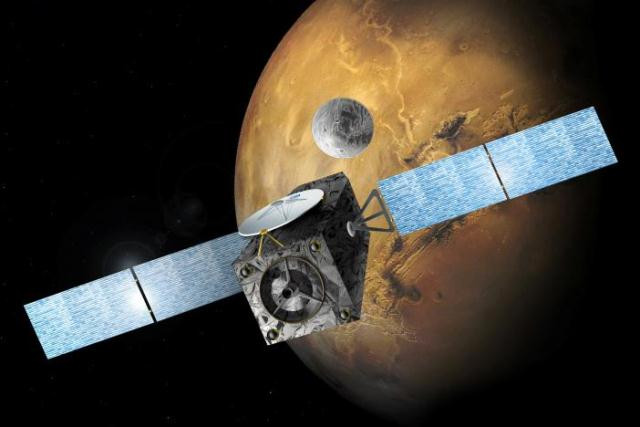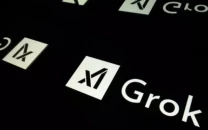Anxious wait for news of Mars lander's fate
The European Space Agency (ESA) confirmed the craft had touched down, but said it was emitting no signal

An illustration released by the European Space Agency (ESA) shows the Schiaparelli EDM lander. The Schiaparelli lander is due to touch down on the red planet October 19, 2016, in Europe's first attempt to land a craft there since the Beagle 2's 'heroic failure' more than a decade ago. PHOTO: REUTERS
The paddling pool-sized "Schiaparelli" lander, a trial-run for a Mars rover to follow, was scheduled to land at 1448 Wednesday after a scorching, supersonic dash through Mars' thin atmosphere. Hours later, the European Space Agency (ESA) confirmed the craft had touched down, but said it was emitting no signal -- evoking the ghost of Europe's first, failed, bid to land on Mars 13 years ago.
"The lander touched down, that is certain," ESA's Schiaparelli manager Thierry Blancquaert told AFP.
Robot explorers headed for Mars quest: ESA
"Whether it landed intact, whether it hit a rock or a crater or whether it simply cannot communicate, that I don't know," he said from mission control in Darmstadt, Germany.
 A full-size model of the European ExoMars entry, descent and landing module, Schiaparelli, with its parachute deployed revealed on ESAÕs open day on October 4, 2016 in the Netherlands. PHOTO: REUTERS
A full-size model of the European ExoMars entry, descent and landing module, Schiaparelli, with its parachute deployed revealed on ESAÕs open day on October 4, 2016 in the Netherlands. PHOTO: REUTERSBlancquaert said he was "not too optimistic" of receiving a clean bill of health. This would be Europe's second failed Mars landing in a row, joining a string of other unsuccessful attempts by global powers to explore our planetary neighbour's hostile surface.
The British-built Beagle 2 robot lab disappeared without trace after separating from its mothership, Mars Express, in 2003. Its remains were finally spotted in a NASA photograph last year. Schiaparelli had travelled seven months and 496 million kilometres (308 million miles) onboard the European-Russian Trace Gas Orbiter (TGO) to come within a million kilometres from Mars on Sunday, when it set off on its own mission to reach the surface.
The pair comprised phase one of the ExoMars mission through which Europe and Russia seek to join the United States in probing the alien Martian surface. The TGO was successfully placed in Mars orbit on Wednesday, to cheers and applause from ground controllers some 170 million kilometres away.
"It's a good spacecraft in the right place, and we have a mission around Mars," flight operations manager Michel Denis announced. Schiaparelli's silence put a damper on the celebrations, though ESA officials tried to look on the bright side.
China sends two astronauts to space lab
"Whatever is going to happen, we will have learnt a lot of things because we will have data recorded of the descent," spokeswoman Jocelyne Landeau-Constantin told AFP.
"So, we already have quite a bit of lessons learnt." For ESA director-general Jan Woerner, "this is typical for a test".
"We did this in order to get data about how to land with European technology on Mars, therefore all the data we will get this night... will be used to understand how to manage... the next landing when we're going with the rover."
Schiaparelli's landing was designed to inform technology for a much bigger and more expensive rover scheduled for launch in 2020 -- the second phase and high point of ExoMars. The rover will be equipped with a drill to look for clues of life, past or present, up to a depth of two metres.
The TGO, in turn, will aid the search for life by sniffing atmospheric gases potentially excreted by living organisms -- however small or primitive. Its science mission will start in early 2018.
While life is unlikely to exist on the barren, radiation-blasted surface, scientists say traces of methane in Mars' atmosphere may indicate something is stirring under the surface -- possibly single-celled microbes. For a safe landing, Schiaparelli had to brake from a speed of 21,000 kilometres (13,000 miles) per hour to zero, and survive temperatures of more than 1,500 degrees Celsius (2,730 degrees Fahrenheit) generated by atmospheric drag.
It was equipped with a discardable, heat-protective "aeroshell" to shield it on its supersonic jaunt through Mars' carbon dioxide-rich atmosphere. It had a parachute and nine thrusters with which to brake its fall, and a crushable structure in its belly to cushion the final impact.
Experts will work through the night to assess the @ESA_EDM situation - next news will be tomorrow morning at 10:00 CEST #ExoMars
— ESA Operations (@esaoperations) October 19, 2016
ESA Operations tweeted late Wednesday, using the acronym for Schiaparelli's full name: "Entry, Descent and Landing Demonstrator Module". The next update will be given at 0800 on Thursday.
First launch for Orbital's Antares rocket since '14 blast
Since the 1960s, more than half of US, Russian and European attempts to operate craft on the Martian surface have failed. Europe has budgeted 1.3 billion euros ($1.4 billion) for its share in the ExoMars project.



















COMMENTS
Comments are moderated and generally will be posted if they are on-topic and not abusive.
For more information, please see our Comments FAQ